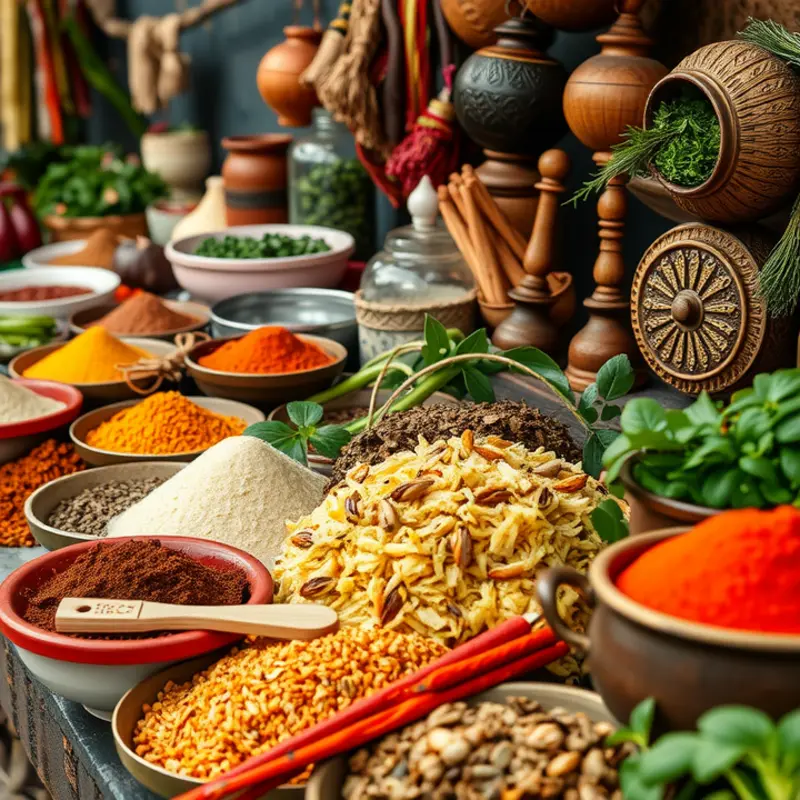From hearty risottos to fragrant biryanis, grains are at the heart of many cherished culinary traditions. They serve not only as a source of sustenance but also as a canvas for cultural stories and customs. Whether it’s delicate sushi or robust paella, each dish tells a tale of history, geography, and community. Join us on an explorative journey to discover how these humble ingredients have woven themselves into the fabric of different cultures, showcasing their importance in global cuisine.
Risotto: Italy’s Creamy Treasure

Risotto, the culinary delight that captures the heart of Italian gastronomy, originates from the fertile fields of Northern Italy. This creamy rice dish not only exhibits Italy’s rich agrarian history but also showcases the country’s ability to elevate simple ingredients into something exquisite. At the core of risotto’s magic lies the quality of the rice used. Arborio, Carnaroli, and Vialone Nano varieties dominate for their high starch content and ability to absorb flavors while maintaining a firm texture.
The origins of risotto can be traced back to Italy’s Piedmont and Lombardy regions during the Renaissance period. Rice cultivation flourished in these areas, thanks to the water-rich landscape ideal for growing rice paddies. Over time, risotto emerged as a staple dish that answered the need for warmth and nourishment during the cold months. Among the classic risottos, Risotto alla Milanese holds a prestigious spot, renowned for its use of saffron, which imparts a golden hue and a floral essence. The legend of its creation tells of a wedding feast in Milan, where an artist’s apprentice accidentally dropped saffron into the risotto pot, resulting in an unforgettable flavor.
Besides saffron, risotto adapts to regional specialties, offering a canvas for local ingredients. In the northern countryside, risottos often feature earthy mushrooms, such as porcini, and wild herbs, infusing the dish with a robust, woodsy aroma. In Veneto, you’ll find Risotto al Nero di Seppia, where squid ink gives it a dramatic black color, echoing the seafaring heritage of Venice. The southern Campania region adds a citrus twist with risottos flavored with Amalfi lemons, while Sicily presents a vibrant pistachio risotto.
Creating the perfect risotto is an exercise in patience and technique. The process begins by gently sautéing onions or shallots in butter or olive oil, providing a sweet, mellow base. Toasting the rice until each kernel is coated in fat enables it to release its starch, leading to the coveted creamy texture. The gradual addition of hot broth, ladle by ladle, along with constant stirring, ensures even cooking and flavor infusion. This meticulous attention to detail transforms risotto from simple rice into a symphony of flavours.
Finishing touches carry their own importance. A generous handful of grated Parmigiano-Reggiano or Grana Padano adds depth, while a knob of butter enriches the texture, lending that luscious creaminess for which risotto is famed. For a twist, explore how flavor boosters without salt can enhance your risotto experience.
Risotto speaks to why food is central to Italian culture, where communal enjoyment transforms meals into celebrations. Whether tracing its historical origins or experimenting with modern variations, preparing and savoring risotto is a journey into the soul of Northern Italy’s culinary tradition.
Biryani: A Symphony of Spices

In South Asia, biryani stands as a testament to the region’s vibrant culinary tradition, weaving together a tapestry of flavors that have been perfected over centuries. This aromatic dish combines long grain basmati rice with marinated meats and intricate spices, painting a picture of the cultural diversity within its borders. Each bite of biryani offers an explosion of taste, where spices like cardamom, cloves, and cumin fuse together, often elevated by a hint of luxurious saffron.
The story of biryani is as rich as its flavors. Legend suggests it was brought to India by Persian travelers and merchants. Over time, local cooks infused their own flavors, making biryani a unique signature dish reflecting regional customs and tastes. Consequently, each part of the Indian subcontinent boasts its own variety.
Hyderabadi biryani, perhaps the most globally recognized, is renowned for its bold spice profile. This variant often includes fiery green chilies and tangy yogurt in the marinade, assuring an explosion of heat and zest in each spoonful. The Hyderabadi version is generally cooked using the dum method, where rice and meat are layered and sealed in a heavy-bottomed pot, employing steam to meld the marinated ingredients into a harmonious blend.
In contrast, Lucknawi, or Awadhi biryani, presents a milder face, drawing influence from the rich culinary traditions of the Nawabs of Awadh. This version features a subtle perfume of spices, with dried fruits and boiled eggs adding both sweetness and richness. It’s fascinating to note how saffron, which is sparingly used, can uplift the dish, making each grain of rice burst with color and aroma.
Beyond these two famous types, biryani has countless other interpretations. The coastal regions often incorporate fresh seafood, while vegetarian versions celebrate the bounty of local produce. Each variation carries a story—of a people, a place, and a palette—in its depths. For those keen on reducing their kitchen waste, using practical ingredient batching can ensure nothing goes to waste while preparing this intricate dish. More insights can be found here.
Culturally, biryani is more than a meal. It’s a celebration dish, bringing people together during festivals, weddings, and special occasions. Each serving not only nourishes but also serves as a reminder of the rich legacy of trade and cultural exchange in South Asia. It stands as an edible emblem of the region’s layered and complex history.
In your quest to recreate biryani at home, focus on the balance of spices and the quality of rice, as these are the soul of the dish. The journey through South Asian cuisine is a journey through the heart of its communities, and biryani will always remain its most fragrant ambassador.
Final words
Grains are far more than mere sustenance; they are deep-rooted in social customs and heritage. Each dish we explored has its own story, reflecting the environment, history, and people behind it. From the creamy embrace of risotto to the aromatic complexity of biryani, these iconic grain dishes form a bridge across cultures, inviting us to savor not only their flavors but also the stories they tell. As you continue your culinary adventures, may these dishes inspire you to appreciate the role of grains in unifying diverse cultures through food.








